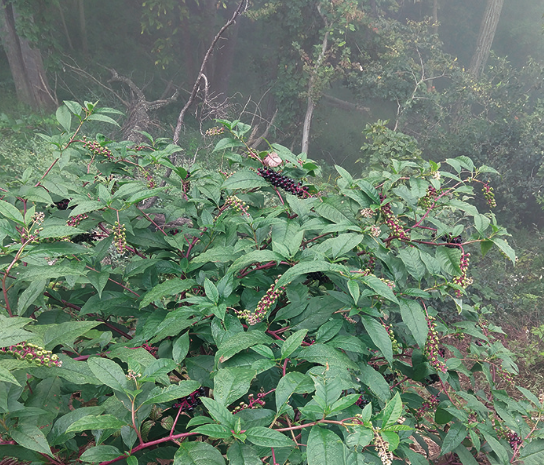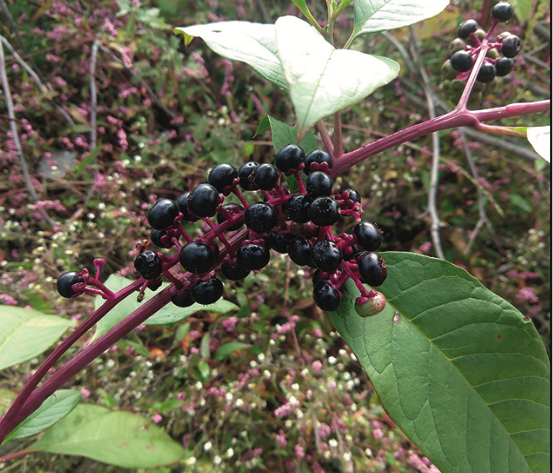by Kate Shunney

 Clusters of dark purple berries look extra appetizing in the fall as trees and shrubs are losing their color. In a dry spell, pokeweed’s bright red stems and berries are a real stand out plant in fields and at the edge of forest openings and dirt roads.
Clusters of dark purple berries look extra appetizing in the fall as trees and shrubs are losing their color. In a dry spell, pokeweed’s bright red stems and berries are a real stand out plant in fields and at the edge of forest openings and dirt roads.
Pokeweed is native to our part of the world. Some say its name – poke – is a version of the Algonquin word “pocan” or “puccoon” meaning a plant that contains dye.
Deep purple is the color of the poke berry when ripe. On its long berry cluster, fruit can be at every stage of ripening – from pale green to reddish green to blackish purple. Berries ripen over the course of weeks, depending on moisture and whether the weed is growing in full sun or shade.
Pokeweed can grow from three to 10 feet tall. It tends to do well in overgrown fields. A recently-timbered area will fill in fast with plants that were waiting for their chance at full sun, and pokeweed will be one of those plants. While they grow in open areas, they’ll also show up right at the edge of the woods or a lane through a forest, where the sun can reach them.
Poke berries aren’t the only place the plant holds color. Stems of mature pokeweed can be bright purplish red, looking like a towering rhubarb stem.
Pokeweed – Phytolacca americana in the botanical world – has been put to use in all sorts of ways over the centuries.
While the bright fat berries look tempting, the leaves, roots and fruit can poison both humans and animals if eaten raw. Rarely deadly, the plant can cause all nature of discomfort to anyone who eats it, from sweating and burning of the mouth and throat to serious gastric problems, blurred vision and even unconsciousness.
On the other side of that slightly dangerous characteristic, poke has been used as medicine for centuries.
According to herbalists and plant biologists, poke has been used as a tonic, a purgative and emetic (causing vomiting or other purging) and as treatment for skin troubles, and even hemorrhoids. Given its slightly poisonous nature, the preparation of the plant or berries into medicine is a tricky business.
Some folks have been known to take the young leaves and boil them twice (throwing away the boiling water in between steps) to make an edible green. Young shoots reportedly can be eaten as similar to asparagus. Ripe berries can provide the coloring for wine, and cooked berries made into pie, according to old timers.
The ripe berries can be mashed up and the berry juice used for coloring. But like most natural dyes, the tint is much paler than the shiny purple-black of the fruit, and fades easily in sunlight if not properly fixed by dyemakers. Some recipes for making dye from pokeweed call for adding vinegar to keep the colors vibrant. Acid, it seems, is the magic ingredient. Even so, the color intensity of fabric or wool dyed in pokeberry juice is said to range from pale pink to brighter magenta.
Whether it is considered a “weed” or a regional wild- flower, the often-towering pokeweed stands out this time of year along forest edges and in the fading color of fields. Handled with care, it is both useful and fascinating.




